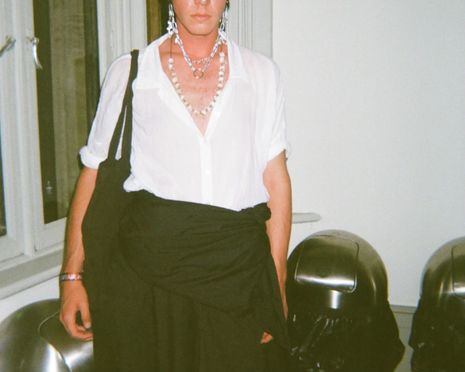Style and social class: Love me, love me not
Working class influence over high fashion does not signify a reclaiming of power over taste, argues Alicia Powell

The fashion industry is forgetful: what may be once considered unfashionable and unrefined ultimately becomes repackaged as the latest trend. Signifiers of working-class style – forms of excessive consumption once deemed vulgar and lacking in distinction – find a new home in the wardrobes of the wealthy. The so-called ‘chav’ uniform ridiculed through characters like Vicky Pollard boils down to a specific rule: the more brands, the better. Sound familiar? Stone Island, Nike, Lacoste, Fred Perry, Ralph Lauren, Adidas. All these brands exist at the centre of hypebeast culture. Once a visual signifier of poverty, these styles have been re-purposed into high-fashion streetwear.
“What’s in and what’s out is and will always be dictated by the workings of high fashion”
There may be an inclination to feel pride at this resurgence of working-class style; that despite the changes in our social fabric since the declines of industry, the working class has established its own valid identity free of the establishment. However, I would encourage you to ask yourself: how did it get there? The answer - the same way anything gets anywhere in the trickle-down fashion system we are subject to – is from the top. As Meryl Streep illustrated through her cerulean sweater monologue in The Devil Wears Prada, it is ‘sort of comical how you think you made a choice that exempts you from the fashion industry when, in fact, you’re wearing a sweater that was selected for you by the people in this room from a pile of stuff.’
While what we see in these new trends is mere appropriation of the working-class originals, what’s in and what’s out is and will always be dictated by the workings of high fashion. The ultimate mission of these fashion houses is to maintain their exclusivity and unattainableness.
The now-infamous paparazzi shot of Danniella Westbrook wearing a Burberry skirt and a Burberry bag, while lifting a child fully kitted in Burberry out of a Burberry buggy was printed by The Sun alongside the caption ‘chavtastic’. From there, the luxury goods house developed an instant association with the imitations and counterfeit of their recognisable luxury and witnessed a rapid decline in sales. Westbrook’s iconic subversion of the label’s heritage print had confirmed the moral panic surrounding the ‘chav’, with even pubs and club beginning to ban the brand from their establishments. Burberry executives rushed to shift the public perceptions of the brand. The first move of Christopher Bailey, appointed creative director in 2004, was therefore to ditch the signature nova check print, distancing the brand from the working class and repairing Burberry’s reputation. By 2005, the print appeared on less than 5% of the brand’s product and production of its chequered caps was altogether ceased.
“High fashion brands continue to invent new exploitative methods of repackaging and selling us back our cultures”
Therefore, watching the upper classes play catch-up shouldn’t be a bitter experience. It should feel empowering but, due to the persistent efforts of fashion elites to evade working-class aesthetics, it isn’t. It’s mere imitation. This shift in attitude, from mistrust and mockery to fetishization and desire, reeks of hypocrisy and reaches offensive heights of appropriation.
In 2014, after thirteen years at Burberry and ten years as creative director, Christopher Bailey decides to revive the Burberry nova check print by marketing it as young, fresh and desirable. The height of this reappropriation arrives in his penultimate collection as creative director, in the FW17 show which showcases the heritage of the brand by returning to the catwalk the tartan print that birthed Burberry’s ‘chav’ perception. Streetwear reunites with its ex-lover in March 2022 through the Supreme®/Burberry® collaboration, a collection which offered statement outerwear in that classic check as its selling point. If the gap between the top and the bottom continues to chasm, the appropriation of working-class aesthetics will persist. That gap is maintained through brands like Supreme where the price point keeps these appropriated items out of poor people’s reach.
The axis has spun, as it seems to do every so often and those previously at the bottom now find copies of themselves at the top. The working class, however, remains at the bottom, where we’ve always been, thanks to the configuration of oppression and marginalisation conducted by those stealing our image. This is far from inclusivity. This is far from celebration or tribute. It’s simply another form of oppression, a subconscious and hollow attempt to dilute a very way of life. High fashion brands continue to invent new exploitative methods of repackaging and selling us back our cultures, never engaging in conversations with those for whom this is a lived experience.
The mainstreaming of streetwear may have loosened some class prejudices, but the system itself remains solid. The working-class image exists in a precarious balance, creaking unsteadily against the UK’s turbulent relationship with its own class realities.
 News / Cambridge study finds students learn better with notes than AI13 December 2025
News / Cambridge study finds students learn better with notes than AI13 December 2025 News / Cambridge Vet School gets lifeline year to stay accredited28 November 2025
News / Cambridge Vet School gets lifeline year to stay accredited28 November 2025 Science / Did your ex trip on King’s Parade? The science behind the ‘ick’12 December 2025
Science / Did your ex trip on King’s Parade? The science behind the ‘ick’12 December 2025 News / Uni Scout and Guide Club affirms trans inclusion 12 December 2025
News / Uni Scout and Guide Club affirms trans inclusion 12 December 2025 Arts / Modern Modernist Centenary: T. S. Eliot13 December 2025
Arts / Modern Modernist Centenary: T. S. Eliot13 December 2025








